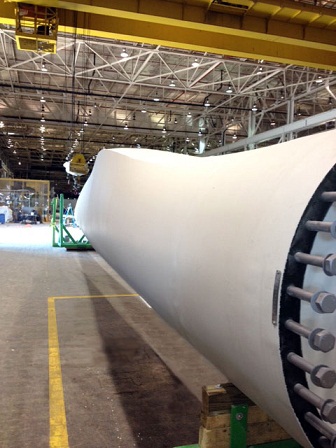
One of the first blades from Global Blade Technology nears completion at the Evansville, Ind., facility.
An issue that hampers development of new small and community wind turbines is the cost of developing suitable blades. New turbines are brought to market with designs aimed at optimizing the cost of energy. Many features typically require developing a new blade to match a unique turbine design and to make sure the turbine actually performs as required. Two design features that tend to have a lot a variation in this market segment are blade-to-hub connections, and the operating philosophy of the turbine: stall, pitch, or tip brake.
In many contacts with small and community turbine OEMs, Global Blade Technology (GBT) CEO Jan Willem van der Werff says the traditional costs to develop a perfectly matched blade are often prohibitively high for a new turbine program. Blade development typically involves:
- A design that frequently starts with a new aero-structural model but is limited by having to also design a new root configuration. Depending on OEM requirements, a full-fledged certification sometimes needs consideration as well. Cases that call for new blade geometry, also call for new molds.
- When these costs are combined with relatively small orders for turbines, and therefore few blades, the amortization of the total blade development costs-per-blade set in the first year or two can be prohibitively high. So high that in many cases, less than the best blade designs will be chosen – or programs don’t start at all.
“To help small and community wind-turbine OEMs overcome these hurdles, we launched the Affordable Blade Development program,” says van der Werff. “Through it, custom designed blades can be delivered to new turbine programs at a cost that meets the program’s needs. He says the program takes several steps to trim costs off of processes. For instance, the engineering team can develop new design routines that require less work and yield needed results. Van der Werff tells of a company in Europe that wanted an eight and nine-meter blade for new 80 and 100 kW turbines. “New blade molds for each would have broken their budget. We found a way to make the eight-meter mold and add a one-meter tip extension so it provided custom blades for each turbine.”
Finite-element analysis ensures mechanical integrity over the design life so the design still meets strict requirements. Through its work with many materials suppliers, GBT adds that it has access to a large bank of Material Design Values that further shorten the cycle. ”This means we can use materials from different companies and still predict the performance of new blades,” says van der Werff.
The company says it has also developed technology that allows optimum tooling for blade manufacturing as well as shipping. Van der Werff says this lets the company manufacture molds and tooling from its factory in Baroda, India at world competitive costs. In many cases the company can also offer to manufacture the blades at this facility, further reducing the costs of the blade sets delivered to the OEM. Beyond the lower-cost-production location, Van der Werff says the company has developed technologies to take costs out of the mold design and production process. Among other techniques, a direct mold technology is available for molds for smaller production series.
The company offers Limited Series Production at all of its manufacturing locations: the Netherlands, U.S., India, and Brazil in 2013.
“What’s more, we use Design for Six Sigma with project-management tools that let us assure the blades meet performance, budget, and timeliness targets.” He adds that results from previous projects are available for inspection.
Global Blade Technology
Gbtholdings.com
Filed Under: Blades, News





Hello-
I am expert in wind power looking for work. I have over 30 years of experience in wind energy.
http://www.zwind.com resume
Ken Bosley, M.A.
410 472 1081
bosley@zwind.com
PO Box 585
Sparks, Maryland 21152 USA